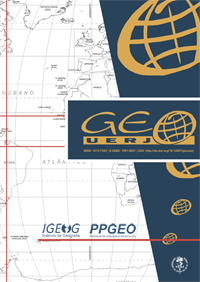GEOGRAFIA, NOVAS TECNOLOGIAS E ENSINO: (RE) CONHECENDO O “LUGAR” DE VIVÊNCIA POR MEIO DO USO DO GOOGLE EARTH E GOOGLE MAPS
DOI:
https://doi.org/10.12957/geouerj.2016.13119Palavras-chave:
Pesquisa-Ação, Ensino de Geografia, Novas Tecnologias, Lugar, Cotidiano.Resumo
doi: 10.12957/geouerj.2016.13119
Tendo em vista que atualmente não se tem como dissociar educação e novas tecnologias, visto que cada vez mais cedo os jovens têm feito uso de ferramentas tecnológicas, o presente trabalho teve como objetivos analisar a experiência desenvolvida no ensino de Geografia, objetivando o conhecimento do “lugar” enquanto espaço de vivência dos alunos, a partir do uso de novas tecnologias, mais especificamente do Google Earth e do Google Maps e do trabalho de campo. O trabalho foi desenvolvido em 2013, com a turma do 8º Ano “C” da E.E.E.F. Maria Emília Oliveira de Almeida, localizada no bairro Presidente Médici, na cidade de Campina Grande/PB. Com a pretensão de alcançar os objetivos teve-se como foco a Pesquisa-Ação. Para tanto, se buscou envolver a comunidade escolar ao processo. Trabalhou-se a partir de revisões teórico-bibliográficas; pesquisa quantitativa; aulas expositivas dialogadas; pesquisa virtual no laboratório de informática, utilização dos softwares Google Earth e Google Maps; aula de campo; registros fotográficos, anotações e discussões e; socialização dos resultados na mostra pedagógica da escola. Constatou-se o fascínio juvenil pelas novas tecnologias, além da forte presença de tais ferramentas inovadoras no convívio diário dos docentes
Downloads
Downloads
Publicado
Como Citar
Edição
Seção
Licença
Os Direitos Autorais dos artigos publicados na Revista Geo UERJ pertencem aos seus respectivos autores, com os direitos de primeira publicação cedidos à Revista. Toda vez que um artigo for citado, replicado em repositórios institucionais e/ou páginas pessoais ou profissionais, deve-se apresentar um link para o artigo disponível no site da Geo UERJ.

Os trabalhos publicados estão simultaneamente licenciados com uma Licença Commons BY-NC-SA 4.0.


